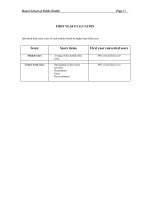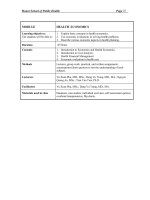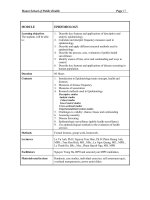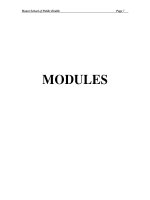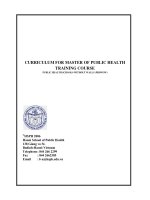Bài giảng Chăn nuôi và môi trường - Chương 5: Chăn nuôi thú y và sức khỏe cộng đồng
Bạn đang xem bản rút gọn của tài liệu. Xem và tải ngay bản đầy đủ của tài liệu tại đây (2.88 MB, 47 trang )
Chương 5:
Chăn nuôi thú y &
sức khỏe cộng đồng
1
Thú y & Sức khỏe Cộng đồng
Tác động 2 chiều:
Môi trường sức khỏe và năng suất vật nuôi
các yếu tố khí hậu, mơi trường (khơng khí, nước)
các yếu tố về quản lý (thiết kế chuồng trại, vệ sinh, quản lý dịch bệnh)
Chăn nuôi - thú y môi trường & sức khỏe con người
ô nhiễm mơi trường: khơng khí, nước, đất
lan truyền mầm bệnh (zoonoses)
an toàn thực phẩm (ngộ độc thực phẩm, các chất tồn dư)
2
Thú y & sức khỏe cộng đồng- VPH
Góp phần nâng cao chất lượng sống con người qua hiểu biết & thực
hành thú y
(FAO & WHO, The contributions to the physical, mental & social well being of humans through an understanding
and application of veterinary science).
Sức khỏe con người luôn gắn với sức khỏe vật ni, thơng qua:
•
hoạt động chăn ni (ơ nhiễm mơi trường, lan truyền mầm bệnh)
•
vận chuyển (vật ni & các sản phẩm của chúng)
•
thức ăn (thịt, trứng, sữa)
•
quần áo
•
thú cưng
3
Thú y & sức khỏe cộng đồng- VPH
- Liên quan đến sự hiểu biết, phịng ngừa & kiểm sốt:
an toàn thực phẩm (food safety)
các bệnh truyền lây giữa động vật & người (zoonotic diseases)
- ngộ độc thực phẩm, nước uống
- tiếp xúc (chăn nuôi, thú y, thú cưng)
- mơi trường (khơng khí, nước, đất)
- truyền bệnh qua các vật chủ trung gian
4
An toàn thực phẩm
- ATTP là 1 trong các vấn đề quan trọng nhất trong việc:
bảo vệ sức khỏe con người
nâng cao chất lượng sống
- “Food chain” là 1 mắt xích quan trọng trong việc bảo đảm VSATTP:
từ khâu sản xuất – chế biến - phân phối – tiêu dùng
Đòi hỏi sự tham gia của mọi người:
- người sản xuất - kinh doanh – chế biến - phân phối - các cơ quan quản lý & người tiêu dùng
5
An toàn thực phẩm
Các chất tồn dư
- kháng sinh (phòng bệnh, tăng trưởng)
Các chất/ tác nhân thay thế ?
- chất kích thích tăng trưởng
- kim loại nặng (thủy sản)
- thuốc diệt côn trùng (thủy sản)
6
An toàn thực phẩm
Mầm bệnh truyền lây giữa động vật & người
- vật nuôi mang vi sinh vật gây bệnh
- bản thân vật nuôi mang mầm bệnh
- vật nuôi nhiễm mầm bệnh trong quá trình vận chuyển (phương tiện
vận chuyển)
- ơ nhiễm quầy thịt:
- trong q trình giết mổ
- trong quá trình vận chuyển & phân phối
7
Vai trò của thức ăn gia súc
Nhiễm các mầm bệnh lan truyền giữa động vật & người:
- bovine spongiform encephalopathy (BSE)
- Salmonella, enterohaemorrhagic Escherichia coli & các mầm bệnh khác
- aflatoxin
Các biện pháp phòng ngừa:
hạn chế hay cấm sử dụng 1 số thành phần thức ăn gia súc
(ví dụ các thực phẩm từ động vật bệnh)
cải tiến khâu chế biến (tiêu diệt mầm bệnh; tránh nhiễm)
chú ý nguồn gốc thực phẩm
(bổ sung)
8
Bệnh truyền lây giữa động vật & người
(zoonoses)
Zoonoses = communicable diseases
= Bất kỳ mầm bệnh lan truyền 1 cách tự nhiên từ động vật sang người
> 200 bệnh lan truyền giữa động vật & người
- Truyền lây bệnh giữa động vật & người xảy ra hàng ngày, ở mọi nơi trên
thế giới
- Các mầm bệnh: vi khuẩn, ký sinh trùng, virus, & những mầm bệnh khơng
truyền thống (ví dụ, prion)
9
Bệnh truyền lây giữa động vật & người
(zoonoses)
Rất nhiều bệnh truyền lây bệnh giữa gia súc & người:
các bệnh có tính dịch địa phương (endemic):
brucellosis, anthrax, bovine tuberculosis,
campylobacteroses, E. coli O157
parasitic diseases
rabies
các bệnh mới nổi dậy (emerging zoonoses):
avian influenza, Nipah/Hendra disease*
Bovine Spongiform Encephalopathy (BSE)
Hendra disease: caused by Hendra virus, transmitted from horses to human, causing an influenza-like
10
illness, respiratory and renal failure, meningitis & death. Wild bats may be natural carriers.
Zoonoses & sức khỏe cộng đồng
Trong thập kỷ qua, ~ 75% các bệnh mới trên người có nguyên nhân là
các mầm bệnh có nguồn gốc từ động vật hay sản phẩm động vật
1 số mầm bệnh có khả năng lan truyền ở phạm vi rộng hay toàn cầu
Những bệnh đã biết & có thể kiểm sốt như rabies, brucellosis,
echinococcosis vẫn hoành hành ở các nước đang phát triển
11
Zoonoses & sức khỏe cộng đồng
Tác động của các bệnh zoonoses:
ảnh hưởng sức khỏe con người
hạn chế:
• sự sản xuất thực phẩm
• giao dịch hương mại tồn cầu
Từ đó ảnh hưởng đến tồn diện đời sống xã hội
Thú y đóng vai trị quan trọng trong việc ngăn ngừa & kiểm soát các
bệnh zoonoses
12
Zoonoses- đường truyền lây
Thức ăn, nước uống
Qua tiếp xúc
Bị động vật mang trùng cắn, cào xước: rat-bite fever, rabies, rickettsialpox
(Rickettsia akari)
Nước bọt (liếm): rat-bite fever, Ebola, pasteurellosis
Môi trường
Đất: toxoplasmosis, tetanus
Khơng khí: ebola, SARS-CoV, influenza, Q fever (Coxiella burnetii)
Vật chủ trung gian (côn trùng):
- Rocky Mountain spotted fever (Rickettsia rickettsii); dogs, wild rodents,
rabbits - tick
- Sleeping sickness (Eastern equine encephalomyelitis virus - birds, poultry,
horses - mosquitoes
13
Bệnh qua thực phẩm & nước uống
(foodborne & waterborne diseases)
- Mỗi năm, vài triệu người mắc bệnh truyền lây từ động vật qua thức ăn (WHO)
- Có > 250 bệnh ngộ độc thực phẩm, hầu hết là do vi sinh vật (CDC)
- 1 số mầm bệnh gây ngộ độc thực phẩm phổ biến:
Salmonella; Campylobacter, E. coli O157:H7,
Calicivirus, or Norwalk-like virus
- 1 số mầm bệnh gây ngộ độc thực phẩm & bệnh qua nước
Shigella
Viêm gan siêu vi A (hepatitis A)
Giardia lamblia & Cryptosporidium
- 1 số vi khuẩn gây ngộ độc thực phẩm qua độc tố
Staphylococcus aureus
Clostridium botulinum
14
Giardia lamblia
Hosts:
Humans, cats, dogs, cows, beavers, deer, sheep & birds
Giardia infection occur through ingestion of dormant cysts
in contaminated water, food, or
by the fecal-oral route (through poor hygiene practices).
The Giardia cyst
can survive for weeks to months in cold water,
can be present in contaminated wells & water systems, &
even clean-looking mountain streams.
They may also occur in city reservoirs & persist after water treatment,
-- as Giardia cysts are resistant to conventional water treatment methods such as
chlorination & ozonolysis
15
Cryptosporidium
Hosts: mammals, including human
Exposure risks:
C.muris oocysts found in
human feces.
- People who swim regularly
- Parents of infected children
- People who take care of other people with cryptosporidiosis
- Backpackers, hikers, and campers who drink unfiltered, untreated water
- People, including swimmers, who swallow water from contaminated sources
- People who handle infected cattle
- People exposed to human feces through sexual contact
-certain strains of Cryptosporidium are chlorine-resistant
16
1 số bệnh “zoonoses”– vi khuẩn
- Các bệnh gây sốt, tiêu chảy, đau bụng, chống váng, nơn mửa:
salmonellosis; campylobacteriosis, E. coli, shigellosis
- Hay các bệnh khác như:
anthrax, leptospirosis, brucellosis,
tularaemia (= rabbit fever, caused by Franciasella tularensis)
Primary vectors: ticks, deer flies, arthropods
Reservoir host: rabbits, prairie dogs, hares & rodents
Also waterborne
- very rapidly onset, with headache, fatigue, dizziness, muscle pains, loss of appetite & nausea;
face & eyes redden and become inflamed;
inflammation spreads to the lymph nodes, which enlarge & may suppurate;
high fever; death may result
17
Rat bite fever
- Streptobacillus moniliformis & Spirillum minus
-Động vật mang trùng:
thú gậm nhấm
chó, mèo ??
- Vi khuẩn tiết ra nước tiểu, dịch tiết màng nhầy, nước bọt
- Người nhiễm do:
- thú mang trùng cắn hay cào xước
- ăn thức ăn, nước uống bị nhiễm khuẩn;
- tiếp xúc - nước bọt?
18
Rat bite fever
2 dạng bệnh do S. moniliformis
- Haverhill fever (HF): bệnh khi người ăn hay uống những món bị nhễm khuẩn
- Rat bite fever: bệnh do người bị cắn hay cào xước
fever, chills, pharyngitis, vomiting, skin rashes & polyarthralgia
Later: monoarthritis, polyarthritis, anaemia, endocarditis, pericarditis,
pneumonia, meningitis, diarrhoea & abscess formation in organs including the
brain, liver, spleen & skin
Other complications: parotitis, amnionitis, tenosynovitis, prostatitis &
pancreatitis
- Parotid gland: One of the largest pairs of salivary glands that lie at the side of the face just below and in front of the
external ear along the posterior border of the ramus of the mandible.
19
- Tenosynovitis: inflammation of a tendon and its fluid-filled sheath. It is painful, and may temporarily disable the affected
part.
Rat bite wounds on
the finger of a 5year-old male 12
hours after the bite
appear noninflammatory.
Because of fever,
chills, headache, &
rash 5 days later,
blood cultures were
obtained which
grew
Streptobacillus
moniliformis.
Rat-Bite Fever. Close-up view of the rash
of an infant who was bitten on the right
cheek by a rat.
Red Book Online Visual Library, 2006. Image 108_01. Available at:
Accessed December 3, 2007
20
Rat bite fever
Maculopapular rash on the hand of a patient
with confirmed S. moniliformis rat bite fever.
Courtesy of Dr. S.H.A. Peters (Flevostad
Ziekenhuis, Lelystad, The Netherlands).
21
1 số bệnh “zoonoses” – virus
-
Rabies: trên thế giới mỗi năm có khoảng 55 000 người (chủ yếu là trẻ em) chết do bệnh
dại (WHO)
-
Avian influenza
-
Crimean-congo haemorrhagic fever (tick-borne viral disease)
-
Ebola (transmitted by direct contact or airborne transmission)
-
Rift valley fever (caused by the RVF virus);
animals – human; spread by the bite of infected mosquitoes
fever, headache, myalgia and liver abnormalities
hemorrhagic fever syndrome, meningoencephalitis
-
Norwalk-like virus (Norovirus)
-
Viêm gan siêu vi A (hepatitis A)
Myalgia; Muscular pain or tenderness
22
Viêm gan siêu vi A (hepatitis A)
- self-limited & fulminant disease
- low mortality, high morbidity & socio-economic losses
- # 40% of all acute viral hepatitis is caused by HAV
What is the cause?
- Hepatitis A virus (HAV):
genus of Hepatovirus, family of Picornaviridae
nonenveloped, +ve stranded RNA
How is HAV spread?
- typically by the faecal-oral route
Ingestion of fecal matter, even in microscopic amounts,
from close person-to-person contact, or
ingestion of contaminated food or drinks.
23
Viêm gan siêu vi A (hepatitis A)
- HAV is abundantly excreted in faeces:
- can survive in the environment for prolonged periods of time
- resistant to detergent, acid (pH 1), drying, & temp. up to 60oC.
- can survive for months in fresh and salt water
- Food-borne outbreaks are not uncommon
ingestion of shellfish cultivated in polluted water - high risk
- Hepatitis A has been caused by orange juice, salads, bakery goods & lettuce
- HAV can be inactivated by:
chlorine treatment (drinking water), formalin (0.35%, 37oC, 72 hrs),
peracetic acid (2%, 4 hrs), beta-propiolactone (0.25%, 1 hr), &
UV radiation (2 μW/cm2/min).
CDC; WHO; FAO
24
Worldwide endemicity of HAV infection
HAV
endemicity
Regions by
epidemiological pattern
Average age
of patients
(years)
Most likely mode of
transmission
Very high
Africa, parts of South America,
the Middle East and of southeast Asia
under 5
- person-to-person
- contaminated food &
water
High
Brazil's Amazon basin, China
and Latin America
5-14
- person-to-person
- outbreaks/
contaminated food or
water
Intermediate
Southern and Eastern Europe,
some regions of the Middle East
5-24
- person-to-person
- outbreaks/
contaminated food or
water
Low
Australia, USA, Western Europe
5-40
- common source
outbreaks
Very low
Northern Europe and Japan
(WHO)
over 20
- exposure during travel
to high endemicity
areas, uncommon
source
25



